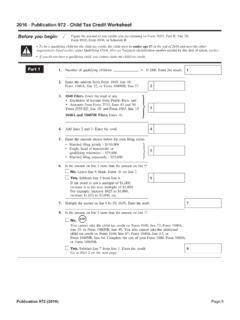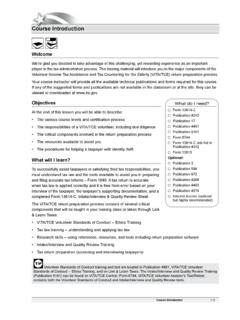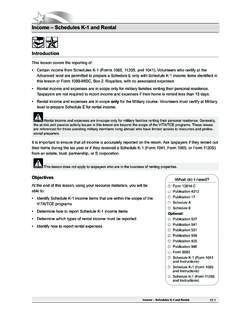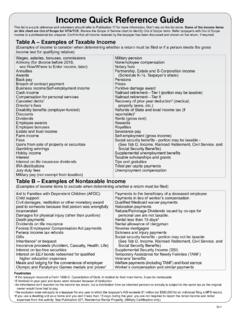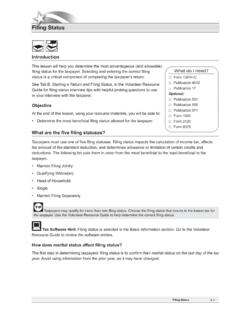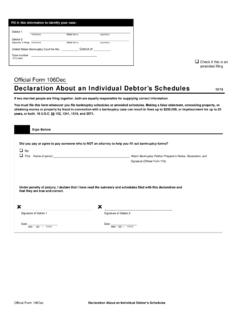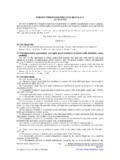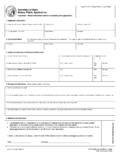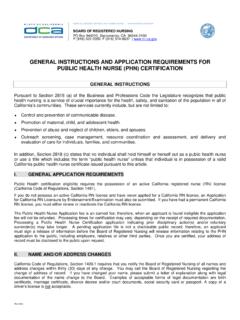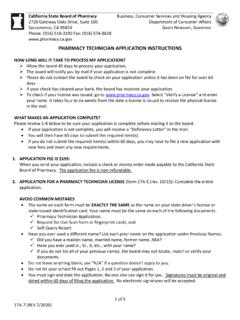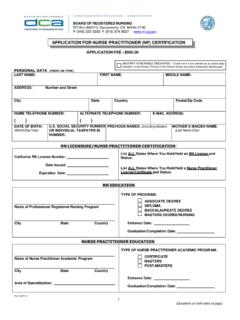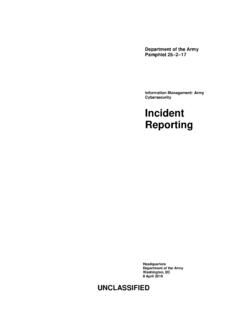Transcription of Dependents - IRS tax forms
1 Dependents6-1 DependentsIntroductionIdentifying and determining the correct number of Dependents is a critical component of completing the taxpayer s return. The deduction for personal and dependency exemptions is suspended for tax years 2018 through 2025 by the Tax Cuts and Jobs Act. Although the exemption amount is zero, the ability to claim a dependent may make taxpayers eligible for other tax benefits. For example, the following tax benefits may all be associated with a dependent : child tax credit, additional child tax credit, credit for other Dependents , earned income credit, child and dependent care credit, head of household filing status, and other tax the Volunteer Resource Guide, Tab C, Dependents for helpful probing questions to use when interviewing the the interview is complete, the results are documented on the intake and interview sheet.
2 This information will be the basis of your entries in the tax do I need? form 13614-C Publication 4012 Publication 17 Optional: Publication 501 form 2120 form 8332 ObjectivesAt the end of this lesson, using your resource materials, you will be able to: Determine if a taxpayer may claim a dependent by applying the applicable dependency testWho are Dependents ? Dependents are either a qualifying child or a qualifying relative of the taxpayer. The taxpayer s spouse cannot be claimed as a dependent . Some examples of Dependents include a child, stepchild, brother, sister, or parent. individuals who qualify to be claimed as a dependent may be required to file a tax return if they meet the filing do I apply the dependency tests?The Marital Status and Household Information section of the intake and interview sheet addresses the issues concerning dependency, but you will still need to use your interview skills to clarify whether the individuals listed are eligible to be claimed as caution when preparing this section of the taxpayer s return.
3 Use the Volunteer Resource Guide, Tab C, Dependents , for guidance on asking probing questions to verify the information on the intake and interview sheet. Avoid using information from the taxpayer s prior year documents to complete this do I use the Volunteer Resource Guide?Refer to Tab C, Dependents , in the Volunteer Resource Guide for tools to assist you in determining if a taxpayer may claim a dependent . Whether you are a new or returning volunteer, Tables 1, 2, and 3 provide interview tips with guidelines and definitions to help you apply the dependency tests. They incorporate all of the exceptions, such as the special rules for children of divorced or separated parents as well as the special multiple support rules. Dependents6-2 When determining if a taxpayer can claim a dependent , always begin with Table 1: All Dependents .
4 If you determine that the person is not a qualifying child, then move to Table 2: Qualifying Relative Dependents . Depending on the taxpayer s answers, you may also be prompted to use Table 3: Children of Divorced or Separated Parents or Parents Who Live Apart or you may use the Qualifying Child of More Than One Person chart. All of these tools are found in the Volunteer Resource Guide, Tab C, Dependents . As you become more experienced with the qualifying child and qualifying relative rules, you may find that you prefer the Overview of the Rules for Claiming a dependent chart tests must be met for all Dependents ? A dependent may be either a qualifying child or a qualifying relative. Both types of Dependents have unique rules, but some requirements are the same for both.
5 To determine if an individual can be claimed as a dependent , begin with the rules that apply to both qualifying child and qualifying relative Dependents : dependent taxpayer test Joint return test Citizen or resident testDependent Taxpayer TestA taxpayer (or taxpayer s spouse, if filing a joint return) who may be claimed as a dependent by another taxpayer may not claim anyone as a dependent on his or her own tax return. Part I of the intake and interview sheet asks, Can anyone claim you or your spouse as a dependent ? If taxpayers answer yes, they cannot claim a dependent . Use your interview skills because some taxpayers, particularly students, might not be sure of the answer to this question. An individual is not a dependent of a person if that person is not required to file an income tax return and either does not file an income tax return or files an income tax return solely to claim a refund of estimated or withheld taxes.
6 If this is the situation, the taxpayer should answer no to can anyone claim you as a dependent ? Joint Return TestA married person who files a joint return cannot be claimed as a dependent unless that joint return is filed only to claim a refund of withheld income tax or estimated tax , who had no income, was married in November of the tax year. Ruth s husband had $30,000 income and had a filing requirement. Although Ruth s father supported her and paid for the wedding, he cannot claim her as a dependent because she is filing a joint return with her or Resident TestTo be claimed as a dependent , a person must be a citizen, resident alien, national, or a resident of Canada or Mexico. If a citizen or national legally adopts a child who is not a citizen, resident alien, or national, this test is met as long as the child lives with the taxpayer as a member of the household all year.
7 If all other dependency tests are met, the child can be claimed as a dependent . This also applies if the child was lawfully placed with the taxpayer for legal adoption. Foreign exchange students generally are not residents and do not meet the citizen or resident test; they cannot be claimed as , who is a citizen, adopted an infant boy from Cambodia who lived with her for the entire tax year. Even though Joan s child is not yet a citizen, he meets the citizen or resident test because he was a member of Joan s household for the entire are the tests for a qualifying child?The next step to determine if the taxpayer has a dependent is to apply the rules for a qualifying child. If these tests are not met, see if the tests for a qualifying relative are met.
8 Remember, a person must meet the requirements of either a qualifying child or a qualifying relative to be claimed as a dependent . While reading about these tests, follow steps 5-9 in the Volunteer Resource Guide, Tab C, Dependents , Table meet this test, the child must be: The taxpayer s son, daughter, stepchild, foster child (placed by an authorized placement agency), or a descendant (for example, a grandchild) of any of them The taxpayer s brother, sister, half-brother, half-sister, stepbrother, stepsister, or a descendant (for exam-ple, niece or nephew) of any of themAn adopted child is treated the same as a natural child for the purposes of the relationships described above. For example, an adopted brother or sister is a brother or sister of the taxpayer.
9 An adopted child includes a child who was lawfully placed with a person for legal meet this test, the child must be: Under age 19 at the end of the tax year and younger than the taxpayer (or the taxpayer s spouse, if filing jointly), or A full-time student under the age of 24 at the end of the year and younger than the taxpayer (or spouse, if filing jointly), or To qualify as a student, the child must be enrolled in the number of hours or courses the school considers full-time during some part of at least five months of the year. See Publication 17 for additional details. Any age if permanently and totally disabled at any time during the year. An individual is considered permanently and totally disabled if both of the following conditions apply: He or she can t engage in any substantial gainful activity because of a physical or mental condition.
10 A doctor determines the condition has lasted or can be expected to last continuously for at least a year or can lead to death. Attending an on-the-job training course, correspondence school, or a school offering courses only through the Internet, does not qualify the child as a To meet this test, the child must have lived with the taxpayer for more than half the year. The taxpayer s home is any location where they regularly live; it does not need to be a traditional home. For example, a child who lived with the taxpayer for more than half the year in one or more homeless shelters meets the residency test. Dependents6-4 Exceptions to the Residency TestThe child is considered to have lived with the taxpayer during periods of time when either the child or the taxpayer is temporarily absent due to illness, education, business, vacation, military service, institutionalized care for a child who is permanently and totally disabled, or child who was born (or died) during the year is treated as having lived with the taxpayer for more than half of the year, if the taxpayer s home was the child s home for more than one-half of the portion of the taxable year during which the individual was may claim as a dependent a child who was born or died, or was kidnapped during the year, as long as the other dependency tests are met.
